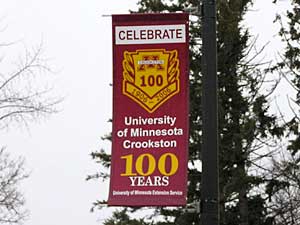|
Photos
|
 |
| University of Minnesota - Crookston officials have been ordered to develop a new mission for the school. (MPR Photo/Bob Reha) |
Moorhead, Minn. — Twelve years ago the University of Minnesota system went through some major changes. The Crookston campus went from a two-year to a four-year program. In a surprise move the Board of Regents closed the University campus in Waseca. Now lean budget times dictate more change, for some there is an underlying concern the board could close the Crookston school.
U of M Executive Vice President Robert Jones says changes are coming but the Crookston campus will remain open.
"Rather than focusing on whether or not the campus will or will not be closing, we're focusing our attention on how do we make that campus strong for the future," says Jones. "So, there are no plans, never have been any plans to close that campus."
The University of Minnesota - Crookston began as an ag school, it's a reputation the college is proud of. But students also get degrees in business, natural resource management and other academic areas.
Chancellor Chuck Casey says a 15-member task force is looking at ways the school can improve in all areas. Casey says developing a new mission is a challenge, especially since there is no money available to fund any new programs.
"Faculty have asked, 'If you're going to add courses or do something new, does that mean we might have to eliminate something?' And my answer has been yes," says Casey.
Task force members haven't completed a final draft of their plan, but one area that will get attention is student recruitment. There are 1,100 full-time students on campus, that's a number Casey would like to see grow.
But the number of kids graduating from area high schools is shrinking. That means the school must recruit more kids outside of northwest Minnesota.
Casey says expanding the school's recruiting base is an obvious part of the mission, but finding the answer to the Board of Regents goal is tougher.
"How do we add value to the University of Minnesota and how do we add value to this part of the state," asks Casey. "It's very much on my mind and on the mind on the members of the task force right now."
Casey says part of the challenge is to find new ways to improve on past success. He says the school has a history of innovation. It was the first four-year college to provide laptop computers to all of its' students.
The Crookston chancellor speaks cautiously about the future, but is willing to consider any changes, if it will strengthen the school. Casey is confident the University of Minnesota - Crookston will be around for a long time.
Senior Carrie Koplin says one of the best things about the school is that the academic programs encourage a hands-on approach. She says there are lots of opportunities for students beyond the usual classroom work. Koplin admits many of her classmates see the Crookston area as isolated and boring. She thinks finding ways to motivate students is essential.
"Students need to get involved on campus, the only way you're going to have stuff to do is if you make stuff for yourself to do," says Koplin. "The opportunities are here, do you want them? That's the question students need to ask themselves."
For some it's a delicate balancing act. Brent Sorenson is an agricultural teacher at the college, he's also a member of the task force. Sorenson says he's open to change, but doesn't want the school to lose track of what it does well.
"We educate them to think, to respond, to take on a challenge, as opposed to some other places that might train them more for graduate school," says Sorenson. "We tend to focus more on finishing your undergraduate (degree) and going into industry."
With Crookston's focus as a poly-technic program, Sorenson thinks the school can do a better job working with local industries to help place graduates. He says the school already has a reputation with employers for graduating students who can step right into a job and be productive. For the future of the school and its students, that could be a key.







